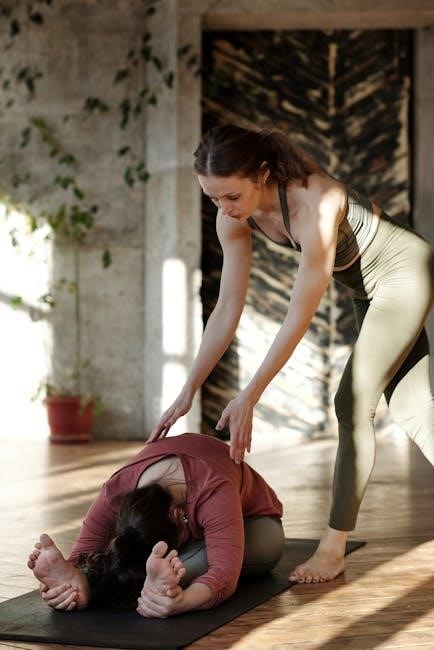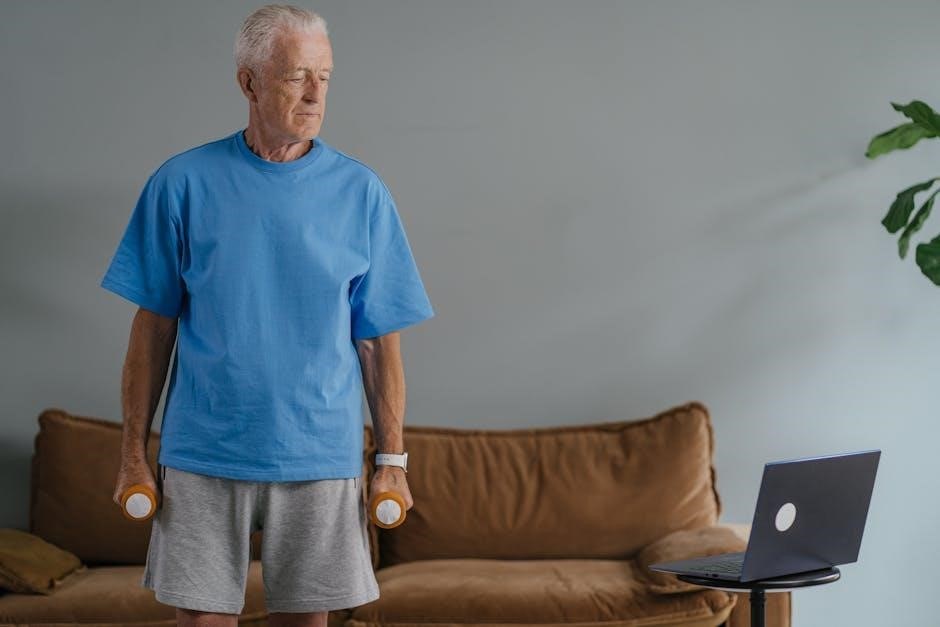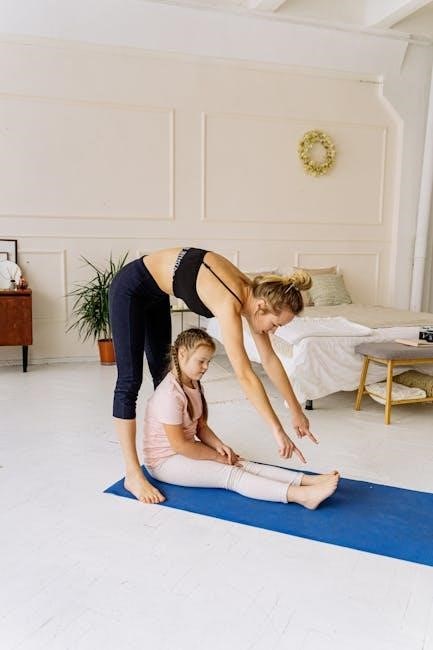Welcome to the Lazy Person’s Guide to Exercise, where we embrace ease and flexibility․ This guide is designed for those who prefer simplicity and minimal effort, offering practical strategies to incorporate physical activity into your lifestyle without stress or pressure․ Discover how small, manageable steps can lead to significant health benefits, all while fitting seamlessly into your laid-back routine․
1․1․ Why Exercise Matters for Lazy People
Exercise is essential for everyone, including those who identify as lazy․ Regular physical activity boosts energy levels, improves mental health, and enhances overall well-being․ Even small, low-effort movements can make a significant difference․ It helps combat sedentary lifestyles, strengthens the body, and increases longevity․ For lazy individuals, exercise doesn’t have to be intense—it’s about finding enjoyable, sustainable ways to stay active․ Consistency, not intensity, is key to reaping long-term benefits and maintaining a healthy, balanced life․
1․2․ Breaking the Myth: Exercise Isn’t Just for the Motivated
Contrary to popular belief, exercise isn’t reserved for the highly motivated․ Anyone, regardless of their energy levels or enthusiasm, can benefit from physical activity․ Lazy individuals often face unique challenges, but simple, enjoyable movements can be just as effective․ Exercise doesn’t require intense workouts or a strict routine․ Small, consistent efforts, like short walks or light stretching, can lead to positive changes․ It’s about finding a balance that works for you, not comparing yourself to others․

Understanding Your Exercise Needs
Understanding your exercise needs involves identifying personal goals, preferences, and lifestyle to create a simple, sustainable routine that fits effortlessly into your life․
2․1․ Identifying Your Fitness Goals
Identifying your fitness goals is the first step toward creating a manageable routine․ Start by setting small, achievable objectives that align with your lifestyle and preferences․ Whether it’s improving energy levels, strengthening muscles, or simply feeling better, your goals should be personal and realistic․ Focus on activities you enjoy to ensure sustainability․ Tracking progress, no matter how minor, helps maintain motivation․ Remember, the aim is to make exercise a habit, not a chore․
2․2․ How Much Exercise Do You Really Need?
Understanding the right amount of exercise is key for lazy individuals․ Aim for at least 20-30 minutes of moderate activity most days, but even shorter sessions can be beneficial․ Start with 10-15 minutes daily and gradually increase as it becomes a habit․ Consistency matters more than intensity․ Focus on movements you enjoy, like walking or light stretching, to make exercise feel less like a chore․ Small, regular efforts add up over time and improve overall health․
2․3․ The Importance of Consistency Over Intensity
Consistency is more crucial than intensity for achieving long-term fitness goals․ Regular, low-effort workouts yield better results than occasional, intense sessions․ Focus on building sustainable habits, such as daily walks or short home exercises, rather than pushing yourself too hard․ Over time, small, consistent efforts lead to meaningful progress without burnout․ Embrace a routine that fits your lifestyle, ensuring exercise becomes a natural part of your daily life․

Setting Realistic Expectations
Setting realistic expectations helps lazy individuals create achievable goals, celebrating small wins, and maintaining steady progress without feeling overwhelmed or discouraged․
3․1․ Setting Achievable Fitness Goals
Setting achievable fitness goals is crucial for lazy individuals․ Start with small, manageable objectives, like a 10-minute walk daily or a few push-ups․ Celebrate progress, no matter how minor, to stay motivated․ Avoid overwhelming yourself with unrealistic targets․ Focus on consistency rather than intensity, allowing your routine to gradually evolve․ Break larger goals into smaller, bite-sized tasks to maintain momentum without burnout․ This approach ensures sustainability and builds confidence over time․
3․2․ Creating a Flexible Workout Schedule
A flexible workout schedule is key for lazy individuals, allowing adjustments to fit your mood and energy levels․ Start with short, manageable sessions, like 5-10 minutes, and gradually increase as comfort grows․ Incorporate varied activities to avoid boredom, such as walking one day and yoga the next․ Use reminders or alarms to stay on track without feeling pressured․ Flexibility ensures sustainability, preventing burnout and keeping exercise enjoyable․ This approach adapts to your lifestyle, making it easier to maintain consistency over time․
3․3․ Overcoming Procrastination
Procrastination often stems from feeling overwhelmed by the idea of exercise․ To overcome this, break workouts into smaller, manageable tasks, like a 5-minute walk or a few stretches․ Set specific, achievable goals and celebrate small wins to build momentum․ Use visual reminders, such as placing workout clothes near the door, to prompt action․ Replace “all-or-nothing” thinking with a “something-is-better-than-nothing” mindset․ Even a short walk can lead to bigger steps, fostering a habit over time without pressure․

Low-Effort Exercise Options
Discover exercises that require minimal effort but yield significant benefits․ Bodyweight exercises, yoga, and walking are perfect for those who prefer ease and flexibility․ No equipment needed!
4․1․ Bodyweight Exercises for Beginners
Bodyweight exercises are perfect for beginners, requiring no equipment and minimal effort․ Start with simple moves like squats, planks, and push-ups․ These exercises strengthen muscles and improve flexibility without intense workouts․ Modify poses, such as knee push-ups, to suit your fitness level․ Perform them at home or outdoors, making exercise convenient and accessible․ Ideal for lazy individuals, bodyweight exercises offer a low-effort way to stay active and healthy without the need for a gym membership or complex routines․
4․2․ The Benefits of Yoga for Lazy People
Yoga is an ideal exercise for lazy individuals, offering a low-effort yet effective way to improve flexibility, strength, and mental well-being․ It requires minimal movement and can be done at home, making it perfect for those who prefer relaxation over intense workouts․ Yoga also reduces stress and enhances balance, providing a holistic approach to health․ With gentle stretches and breathing techniques, yoga caters to all energy levels, making it an accessible and enjoyable option for anyone looking to stay active without exertion․
4․3․ Walking: The Easiest Form of Exercise
Walking is the simplest and most accessible form of exercise, requiring no special equipment or training․ It can be done anywhere, making it perfect for those who prefer convenience․ Regular walking improves cardiovascular health, boosts mood, and increases energy levels․ With its low-intensity nature, walking fits seamlessly into a relaxed lifestyle, offering a hassle-free way to stay active without exertion․ Consistency is key, and even short walks can lead to meaningful health benefits over time․

Incorporating Daily Activities into Your Routine
Transform everyday tasks into opportunities for movement․ Household chores, walking, and gardening count as exercise․ Small, consistent efforts add up, making fitness a natural part of your routine․
5․1․ Turning Household Chores into Workouts
Household chores can be a great way to stay active without feeling like you’re “exercising․” Tasks like vacuuming, mopping, or organizing can raise your heart rate and burn calories․ Even activities like gardening or carrying groceries count as physical activity․ By approaching chores with energy and purpose, you can turn everyday responsibilities into opportunities to move your body․ This approach makes fitness feel effortless and integrates seamlessly into your routine, helping you stay active without extra effort․
5․2․ Taking the Stairs Instead of the Elevator
Taking the stairs instead of the elevator is a simple yet effective way to incorporate physical activity into your daily routine․ It requires minimal effort but can make a significant difference over time․ Climbing stairs burns calories, improves cardiovascular health, and strengthens muscles․ Even a few flights a day can add up․ Plus, it’s an easy way to avoid the monotony of traditional workouts․ Start small and make it a habit—your body will thank you for the extra movement․
5․3․ Gardening as a Form of Exercise
Gardening is an enjoyable and low-effort activity that doubles as exercise․ Whether it’s planting, weeding, or watering, gardening works multiple muscle groups without feeling like a traditional workout․ It allows you to stay active at your own pace, making it perfect for lazy individuals․ Plus, the flexibility to choose tasks based on your energy levels ensures it remains stress-free․ Gardening also offers mental health benefits and a sense of accomplishment as you watch your efforts grow into beautiful results․

Short and Effective Workouts
Discover quick, impactful routines that fit into even the busiest schedules․ From 10-minute sessions to HIIT, these workouts deliver results with minimal time and effort required․
6․1․ 10-Minute Workout Routines
10-minute workouts are perfect for those with limited time or motivation․ These short sessions focus on efficiency, targeting key muscle groups and boosting cardiovascular health․ Simple bodyweight exercises like push-ups, squats, and planks can be combined into quick circuits․ The routines are designed to be done anywhere, eliminating excuses․ Even brief bursts of activity can improve energy levels and overall fitness, making them a great starting point for a lazy person’s exercise journey․ Consistency is key, even in small doses․
6․2․ High-Intensity Interval Training (HIIT) for the Time-Crunched
HIIT is a game-changer for those short on time․ This workout involves short bursts of intense exercise followed by brief rest periods․ Perfect for the time-crunched, HIIT sessions typically last 15-20 minutes and require no equipment․ It’s ideal for lazy individuals who want maximum results with minimal effort․ The combination of efficiency and calorie-burning benefits makes HIIT a great option for fitting exercise into a busy schedule while improving cardiovascular health and boosting metabolism․
6․3․ The Power of Micro-Workouts
Micro-workouts are perfect for those who struggle to dedicate long periods to exercise․ These short, focused sessions (5-10 minutes) can be done anytime, anywhere․ Incorporate activities like stretching during commercials, a quick set of squats while brushing your teeth, or a brisk walk to the mailbox․ Over time, these small efforts add up, improving fitness without feeling overwhelming․ Micro-workouts make exercise manageable and sustainable, proving that even tiny amounts of activity can lead to meaningful progress for the lazy person․
Staying Motivated
Staying motivated begins with finding joy in movement and setting realistic goals․ Use search techniques to discover exercises you enjoy, ensuring consistency and progress over time․
7․1․ Finding Exercises You Enjoy
Discovering enjoyable exercises is key to maintaining motivation․ Explore activities that align with your interests, such as walking, yoga, or even household chores, to make fitness feel natural․ Search online for routines tailored to your preferences, like lazy-friendly workout apps or videos․ Incorporating variety keeps things engaging and prevents boredom, ensuring long-term consistency without feeling forced․
7․2․ Using Rewards to Stay on Track
Rewarding yourself for small achievements is a simple yet effective way to stay motivated․ Set up a system where completing a workout earns you something enjoyable, like a favorite snack, extra relaxation time, or a fun activity․ Choose rewards that personally excite you to maximize their impact․ This positive reinforcement helps build consistency and keeps exercise feeling like a treat rather than a chore, making it easier to maintain over time․
7․3․ The Role of Accountability Partners
Having an accountability partner can significantly boost your motivation to exercise․ Share your goals with a trusted friend or family member and schedule regular check-ins to track your progress․ Knowing someone is counting on you to stay consistent can prevent procrastination and keep you committed․ Additionally, exercising with a partner can make workouts more enjoyable and create a sense of camaraderie․ This shared responsibility helps you stay on track and celebrates your achievements together․

Outdoor and Fun Exercise Ideas
Explore outdoor activities that make exercise enjoyable․ Try walking, cycling, or hiking in nature for a refreshing change from indoor routines․ Fun and variety await!
8․1․ Walking or Hiking in Nature
Walking or hiking in nature is an ideal exercise for lazy people, offering a relaxed way to stay active․ It requires no special equipment, just comfortable shoes and a willingness to explore․ Whether strolling through a local park or hiking on a scenic trail, nature provides a calming environment that makes exercise feel effortless․ Incorporate walking into your routine by replacing short drives with walks or exploring new outdoor spaces․ The fresh air and variety of scenery will keep it enjoyable and prevent boredom, making it easy to stick with consistently․
8․2․ Cycling for Leisure and Fitness
Cycling is a low-impact, enjoyable way to stay fit, perfect for lazy individuals who prefer relaxed pacing․ It’s easy on the joints and can be done at a leisurely speed, making it feel more like recreation than a workout․ Whether biking around your neighborhood, exploring local trails, or using a stationary bike at home, cycling offers flexibility and fun․ Incorporate it into your routine by replacing short drives with bike rides or enjoying casual evening spins․ This activity combines fitness with relaxation, making it sustainable and enjoyable for long-term health․
8․3․ The Benefits of Exercising Outdoors
Exercising outdoors offers a refreshing change of scenery and a variety of low-effort activities․ Fresh air, natural light, and the calming environment of nature can boost your mood and energy levels․ Outdoor activities like walking, cycling, or picnics with light movement are easy to incorporate and require minimal planning․ They also provide a sense of freedom and relaxation, making exercise feel less like a chore․ Plus, outdoor settings often offer built-in motivation, helping even the most laid-back individuals stay consistent with their fitness routines․

Leveraging Technology for Fitness
Technology simplifies fitness by offering apps, wearables, and videos that cater to low-effort routines․ These tools track progress, provide motivation, and make exercise accessible from anywhere, effortlessly․
9․1․ Fitness Apps for Lazy People
Fitness apps are perfect for those who prefer convenience․ They offer personalized workouts, gentle reminders, and progress tracking․ Many apps feature short, manageable routines, ideal for low-motivation days․ With options for bodyweight exercises, yoga, and even guided walks, these apps eliminate the need for gym memberships or complex equipment․ They cater to a laid-back lifestyle, ensuring that even small efforts count toward better health․ This makes staying active surprisingly easy and stress-free, fitting seamlessly into a lazy person’s daily routine․ Additionally, app-based workouts can be done anywhere, providing flexibility and reducing excuses․ By leveraging technology, users can enjoy the benefits of exercise without the hassle, making it easier to maintain consistency over time․
9․2․ Using Wearable Fitness Trackers
Wearable fitness trackers are a game-changer for lazy individuals, offering a hassle-free way to monitor progress․ These devices track steps, calories, and activity levels, providing motivation without requiring intense effort․ They often include features like reminders to move, helping you stay active throughout the day․ By setting simple goals, such as reaching a daily step count, trackers encourage small but consistent efforts․ Their convenience and ease of use make them ideal for integrating into a relaxed lifestyle, serving as a gentle nudge toward better health․
9․3․ Following Along with YouTube Workout Videos
YouTube workout videos are a convenient and accessible way to stay active, especially for those who prefer exercising at home․ With countless free options, you can choose from yoga, Pilates, dance, or quick 10-minute routines․ These videos cater to all fitness levels, allowing you to work out at your own pace․ Plus, you can pause, rewind, or skip sections, making it easy to fit into a relaxed schedule․ They provide structure and motivation without the pressure of a gym environment, perfect for lazy days when you still want to move your body․

Mindset and Psychology
Shifting your mindset is crucial for embracing exercise․ Focus on progress, not perfection․ Celebrate small wins and practice self-compassion to build lasting consistency without pressure․
10․1․ Shifting Your Mindset Toward Exercise
Changing your mindset is key to embracing exercise․ Instead of viewing it as a chore, see it as a small, manageable step toward better health․ Focus on progress, not perfection, and celebrate small victories․ Understand that exercise doesn’t have to be intense or time-consuming to be effective․ By reframing your thoughts, you can transform exercise from a daunting task into a sustainable, enjoyable habit that fits naturally into your lifestyle․
10․2․ Celebrating Small Wins
Celebrating small victories is crucial for staying motivated․ Acknowledge even the tiniest achievements, like walking a bit further or doing an extra rep․ Recognizing progress, no matter how minor, reinforces positive habits and builds confidence․ Reward yourself with something enjoyable, like a relaxing bath or a favorite snack, to create a positive association with exercise․ This approach keeps motivation high and makes the journey feel rewarding, even for the most laid-back individuals․
10․3․ Embracing Imperfection
Embracing imperfection is key to sustaining a lazy-friendly exercise routine․ Understand that consistency matters more than intensity, and it’s okay to have off days․ Celebrate the effort, not just the outcome, and remind yourself that progress is more important than perfection․ Don’t let unrealistic expectations discourage you—small, imperfect steps still lead to meaningful results․ By accepting imperfection, you reduce pressure and make exercise feel more approachable, fostering a healthier, more sustainable mindset․

Nutrition and Recovery
Nutrition and recovery are crucial for supporting your exercise routine․ Focus on balanced meals, hydration, and adequate rest to optimize results without overwhelming yourself․
11․1․ Eating to Support Your Lazy Exercise Routine
Nutrition plays a key role in supporting your exercise routine, even if you’re low on motivation․ Focus on balanced, whole foods like fruits, vegetables, lean proteins, and whole grains to fuel your body․ Hydration is equally important—drink plenty of water throughout the day․ Avoid extreme dieting; instead, opt for small, sustainable changes that fit your lifestyle․ Healthy eating doesn’t have to be complicated or time-consuming․ Simple, nutrient-rich meals can provide the energy you need without requiring much effort or planning․
11․2․ The Importance of Hydration
Staying hydrated is essential for maintaining energy levels and supporting your exercise routine․ Even mild dehydration can reduce motivation and performance․ For lazy exercisers, sipping water throughout the day is a simple, low-effort habit to adopt․ Carry a reusable bottle, set reminders, or add water-rich foods to your meals․ Proper hydration ensures your body functions optimally, making even small physical efforts more manageable and effective without requiring extra effort or time․
11․3․ Rest and Recovery for Optimal Results
Rest and recovery are crucial for your body to repair and strengthen itself after exercise․ For lazy individuals, this means embracing downtime as a natural part of your routine․ Adequate sleep, light stretching, and relaxation can enhance energy levels and prevent burnout․ By prioritizing recovery, you allow your body to heal and adapt, ensuring that even small efforts yield progress․ This approach makes exercise sustainable and avoids the overwhelm of intense regimens․
12․1․ The Long-Term Benefits of Consistent Effort
Consistent effort, even in small doses, leads to significant long-term health benefits․ Regular activity enhances cardiovascular health, boosts mood, and increases energy levels․ Over time, these habits become second nature, promoting overall well-being․ Celebrate every bit of progress, no matter how minor, to stay motivated․ Remember, it’s about steady, manageable steps rather than intense workouts․ Hydration and rest are key to sustaining your routine and enjoying the rewards of your efforts․ This approach ensures lasting results over time․
12․2․ Embracing Progress Over Perfection
Perfection is a myth; progress is reality․ Embracing progress means celebrating small victories, like completing a short walk or doing a few push-ups․ It’s about moving forward, not achieving flawless results․ Perfection can be discouraging, while progress fosters motivation․ By focusing on incremental improvements, you build confidence and reduce pressure․ This mindset aligns with the lazy person’s approach—keeping it simple, enjoyable, and sustainable․ Remember, every step forward is a step toward better health, regardless of how small it seems․
12․3․ Final Tips for Sustaining Your Routine
Consistency is key to sustaining your exercise routine․ Keep it simple by focusing on activities you enjoy and that fit easily into your schedule․ Set realistic goals and celebrate small achievements to stay motivated․ Use reminders or accountability partners to help you stay on track․ Reward yourself for progress, no matter how minor․ Most importantly, stay positive and remember that every bit of effort counts․ Sustainability is about making exercise a lasting habit, not a fleeting trend․